by Sunny | Nov 29, 2018 | 01 What's New, DNA
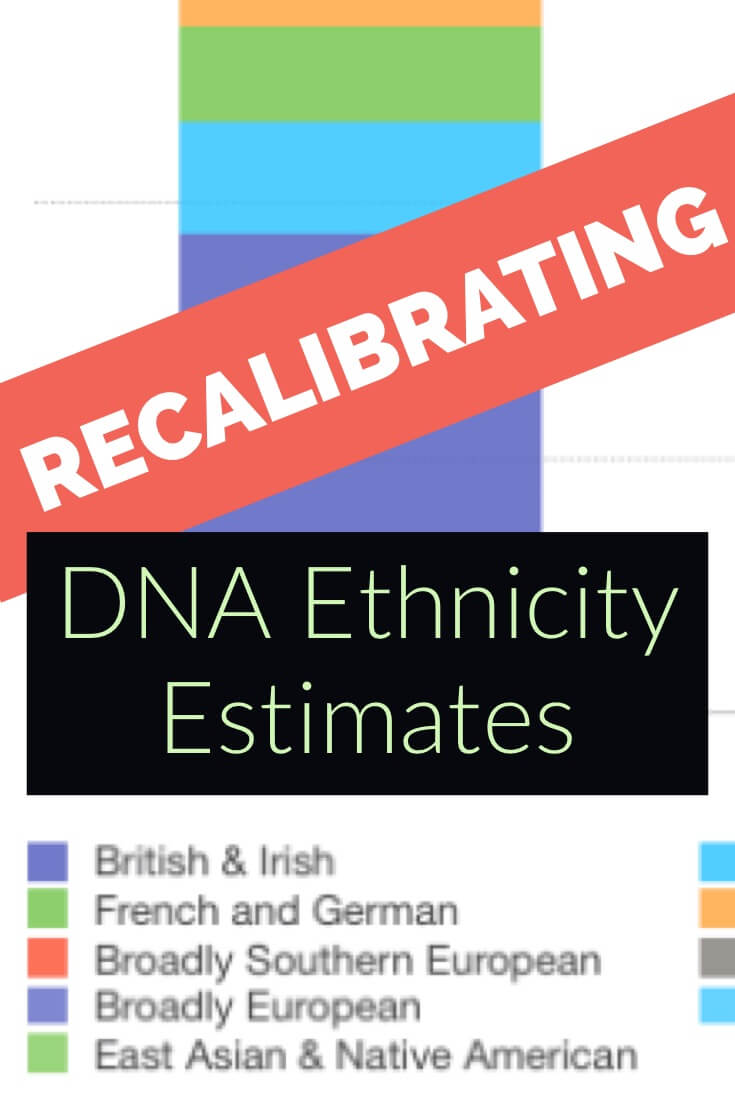 Genealogy testing companies have been hard at work recalibrating your ethnicity calculations based on new and better data. Here’s the latest from Your DNA Guide Diahan Southard.
Genealogy testing companies have been hard at work recalibrating your ethnicity calculations based on new and better data. Here’s the latest from Your DNA Guide Diahan Southard.
Family History DNA Pie Charts and Percentages
Remember that the pretty pie charts and percentages are based on fancy math and reference populations. The initial reference populations released by our testing companies were a great start, but many categories lacked sufficiently high numbers of people to represent all of the facets of a population. In the 10+ years since their release, many updates have been made. But the fancy math that is used to produce our percentages can only be as fancy as the numbers you give it. The numbers have been hard at work at Family Tree DNA, AncestryDNA and 23andMe in the past couple of months with the result being a major overhaul in the way our ethnicity results are reported.
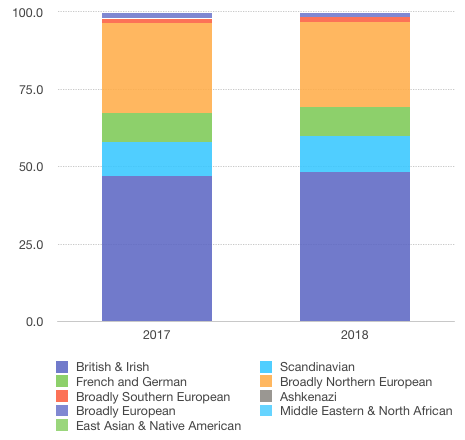
Image 1
23andMe
We recently reported about the update at 23andMe and their increase from 31 reference populations to 150. However, for me, the totally 100% European me, there wasn’t much excitement. As you can see in the 23andMe chart, I had a couple of numbers move up or down slightly, but not anything to write home about. However, I am certain those with South American, or Eastern European ancestry have a much different story. 23andMe added many new reference populations to better represent these underrepresented areas of the world, a move which has likely made a big difference for the ever diversifying pool of individuals who have taken a DNA test.
AncestryDNA
AncestryDNA also released their latest Ethnicity update in September, boasting an additional 13,000 reference samples to their database. They not only upgraded their numbers, but also shifted some of their categories around based on this new data. They seem to not be quite sure what to do with Ireland, as in early 2017 it was its own category, later moving in with Wales and Scotland, and now appears in this latest update as simply Ireland and Scotland. My previous numbers from AncestryDNA seemed to at least loosely reflect my heritage (meaning that I do actually have people in my genealogy chart from a few of these places).
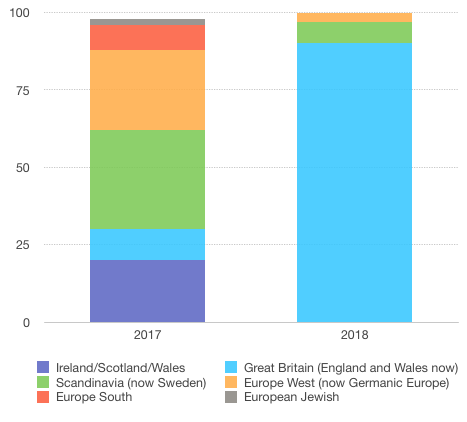
Image 2
But the new DNA numbers? Big Changes.
I have one set of great grandparents from Germany, but it looks like nearly all my German was sucked into England, but miraculously, they seemed to have precisely found my Swedish 2X great grandmother, with the 7% that I should have from that area.
With the new update, though I am sad to see my German go, AncestryDNA is now more fully in line with the results I have received from 23andMe, LivingDNA, and MyHeritage, all of which put my England/British Isles count up around 90%. If I compare my results from various companies and combine any subcategories into one England/British Isles category, indicate Scandinavian, and then lump everything else together, the results from the four companies are actually quite similar (I don’t have my own results at Family Tree DNA, only my parents).
My Family History DNA Results
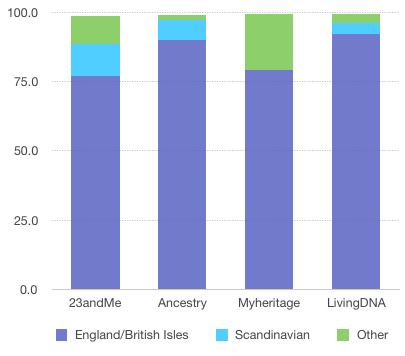
Image 3
Here’s how my results currently stack up at each of these websites. (Image 3)
Which DNA Testing Company to Choose
So which company is the best at all of this? Well, I usually say that if you test everywhere, your “true” answer is likely somewhere in the middle. But really, you can determine which company is best for you by examining their reference populations, and determining which company is most likely able to meet your goals.
In the end, it is always good to remember two things:
- Your DNA does not fully represent your family history, so your ethnicity results can’t possibly tell you everything about your heritage.
- This technology is purposefully titled as an estimate. So be sure you treat it that way.
Learn More about Genetic Genealogy
Recommended reading at Genealogy Gems: Understanding DNA Ethnicity Estimates
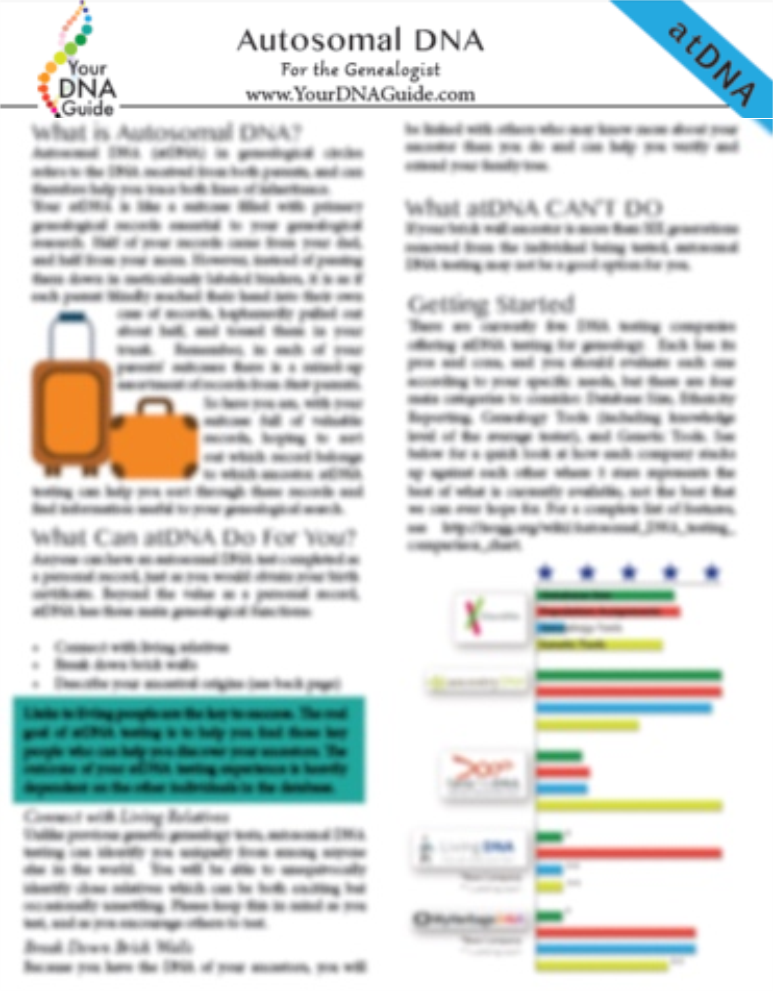
Get Diahan’s quick reference guides including Autosomal DNA for the Genealogist at the Genealogy Gems store.
by Lacey Cooke | Aug 15, 2018 | 01 What's New, DNA, MyHeritage |
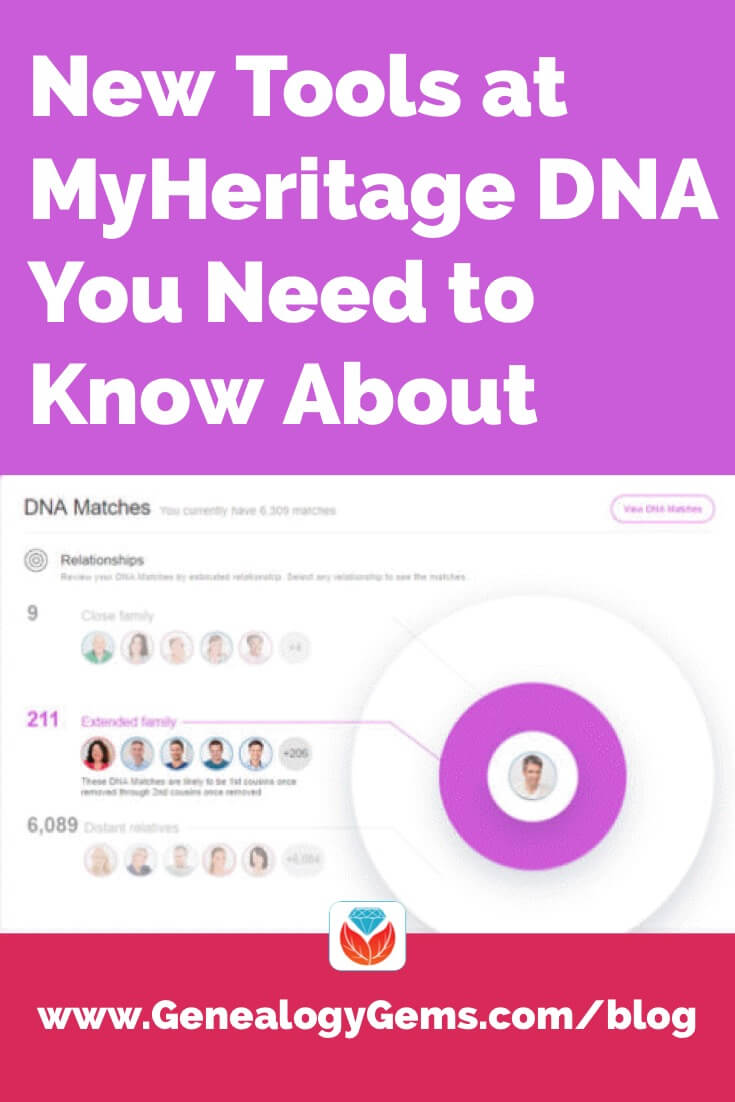 You’ve taken your DNA test for genealogy and anxiously waited for your results. When they arrive, you dive into the ethnicity pie chart. Then matches start rolling in and it can become a little overwhelming to make sense of it all and the benefit it can provide to your genealogy.
You’ve taken your DNA test for genealogy and anxiously waited for your results. When they arrive, you dive into the ethnicity pie chart. Then matches start rolling in and it can become a little overwhelming to make sense of it all and the benefit it can provide to your genealogy.
Thankfully the DNA testing companies are not only focused on advances in testing, but also in creating tools that make it easier for you to interpret and use your results.
MyHeritage DNA continues to release improvements to their DNA product that are meant to both enhance our experience with their website and make it easier to do our genetic genealogy work. You’ll also find an improved presentation of your genetic information that makes it easier to share with your relatives.
The MyHeritage DNA Overview Tab
Just recently MyHeritage DNA announced the addition of new filters for their match page and a bit of a redesign. The small redesign includes moving the ethnicity estimate into a tab right next to the DNA matches tab, as well as adding an Overview tab.
For any relatives who you have convinced to test, but who only show a passing interest in the actual genetic genealogy research, this Overview tab is a great way to show them their results without overwhelming them. There is a simple rundown of the ethnicity results, and then matches are broken up by relationship level and location.
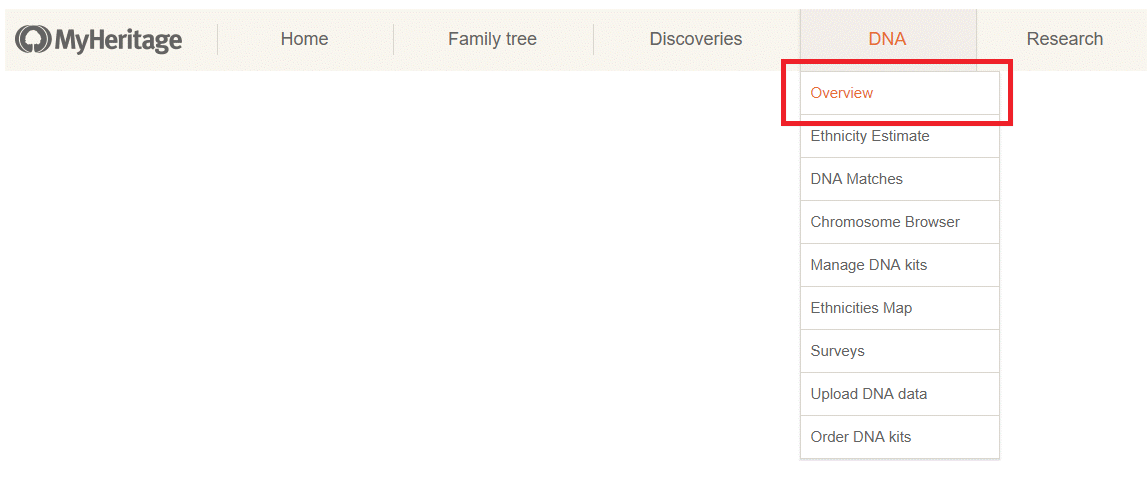
The MyHeritage DNA Location Feature
It is this location feature that will most interest the casual investigator, as well as the serious researcher. This filter lets you see the current location (note: NOT the birth location, though according to the MyHeritage blog post they plan to add birth location in a future update) of your DNA matches. Now, of course, this isn’t an active GPS that is spying on your match, but this tool relies on the location that your match has listed as their location in their MyHeritage account.
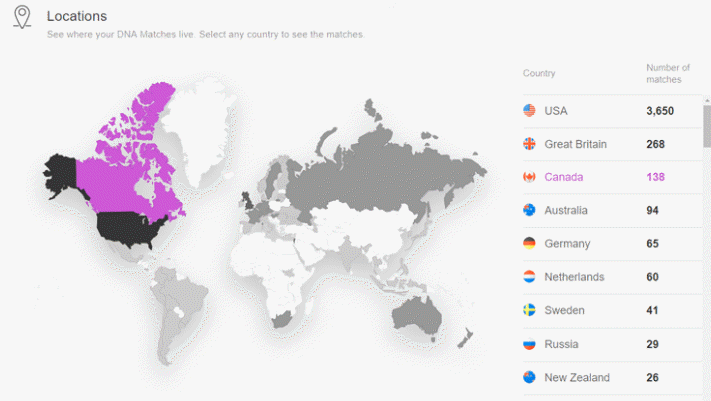
First, it is interesting just to scroll through all of the listed countries and see the variety of locations where your DNA is currently residing. Just think about that for a second: If you are DNA matching with someone in Germany, that means that you are sharing some exact pieces of DNA with someone in Germany and a little bit of you is actually there. This can make for a fascinating exercise when you compare this list of match locations to the locations listed in your ethnicity results. Remember that your ethnicity results can represent your ancestral locations recently, or a very long time ago. So if you see locations on your match list that also appear in your ethnicity results, this might be a good indication that the overlapping location might actually belong in your genealogy. Or the absence of overlap might help you weed out those ethnicities that were thousands of years ago. For example, if you see that your ethnicity results list you as 2% Greek, but you don’t have any DNA matches in Greece, this could mean that your connection to this location is before genealogical time. Of course, it could also mean that the right people from Greece haven’t tested yet, so don’t get too caught up in these deductions.
“If you are DNA matching with someone in Germany,
that means that you are sharing some exact pieces of DNA with someone in Germany
and a little bit of you, is actually there.”
MyHeritage DNA Ethnicities
The last section in the Overview, and the last filter for your match list, shows you how many of your matches are reporting at least 10% of various ethnicities. This might be helpful if you are working your Irish lines, as you can click on Irish, Scottish, and Welsh and see all of your DNA matches who report at least 10% in the Irish, Scottish, and Welsh category.
Combining MyHeritage DNA Filters
Another powerful way to use the filters at MyHeritage is to combine them. On the main match page, you can click on two different filters to further refine your results. So perhaps if you are looking for your Irish ancestor, you might click on the Irish location filter, and then also on the Irish, Scottish, and Welsh ethnicity filter. This will give you all your matches who currently live in Ireland, and who score at least 10% in the Irish, Scottish, and Welsh category.
Of course, the matches that show up after all the filtering aren’t necessarily worth your time or attention. Begin by taking a quick look at how much shared DNA you have. You will want to be sure that you share at least 20 cM before you go spending too much time scouring their pedigree charts for evidence of a shared ancestor.
Likely these filters will continue to improve over time. One thing I would like to see is the ability to use the relationship filter to isolate third cousins, instead of always lumping them with the distant cousins. Most of us don’t have very mysteries in the Extended Family (1st cousins once removed – 2nd cousins once removed) category, so I personally don’t find this filter to be very useful. I would like to see them allow us to filter our best third and fourth cousins out from the rest of our distant matches. Hopefully, MyHeritage can make some refinements in those categories, and thereby make their powerful idea of a two-pronged filter even more effective.
Stay tuned to the Genealogy Gems blog where you will hear updates about MyHeritage DNA (and other DNA testing companies) as they are announced. If you want help in getting more from your DNA test results and using the powerful tools at MyHeritage, my new quick reference guide MyHeritage DNA is available alone or bundled with other DNA resources at the Genealogy Gems store here. Premium eLearning Members can watch the Premium Video Get the Most our of MyHeritage DNA (and download the exclusive handout!) in the Premium Video section here at Genealogy Gems (subscription and sign in required).
What’s your experience using these tools at MyHeritage DNA? Please join the conversation and leave a comment below.
About the Author: Diahan Southard has worked with the Sorenson Molecular Genealogy Foundation, and has been in the genetic genealogy industry since it has been an industry. She holds a degree in Microbiology and her creative side helps her break the science up into delicious bite-sized pieces for you. She’s the author of a full series of DNA guides for genealogists.
Disclosure: This article contains affiliate links and Genealogy Gems will be compensated if you make a purchase after clicking on these links (at no additional cost to you). Thank you for supporting Genealogy Gems!
by Lisa Cooke | Jun 17, 2017 | 01 What's New, Adoption, DNA |
DNA testing for adoptees (and others with unknown parentage) isn’t a last resort–use it along with other strategies to discover biological roots. Genetic genealogists CeCe Moore and Diahan Southard share five tips for getting started.
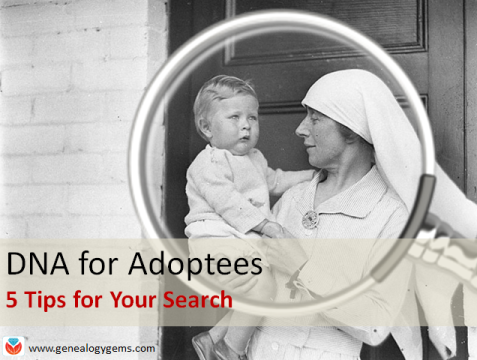
Not long ago, I chatted with genetic genealogist CeCe Moore of The DNA Detectives about using DNA testing for adoptees. Here I summarize some tips she shared, along with some perspectives of my own and resources that can help your search for biological relatives.
Click here to listen to our chat:
DNA testing for adoptees: 5 tips
1. Start with available records. A lot of people of people are coming straight to DNA testing now without looking at any available records first. Adoptees should start by looking at state laws and seeing if they can get access to original birth certificates. Click here to read about access to adoption records (U.S.).
 2. Take an autosomal DNA test. This test looks at both sides of a person’s biological family, mom and dad. Most people start by testing at AncestryDNA because it has the largest database of potential matches (over 4 million now!). If you don’t find a close match (at least a second cousin), you will want to transfer to both Family Tree DNA and MyHeritage for FREE to expand your search radius. Males with unknown paternity should also take a YDNA test (at least at the 37-marker level) from Family Tree DNA.
2. Take an autosomal DNA test. This test looks at both sides of a person’s biological family, mom and dad. Most people start by testing at AncestryDNA because it has the largest database of potential matches (over 4 million now!). If you don’t find a close match (at least a second cousin), you will want to transfer to both Family Tree DNA and MyHeritage for FREE to expand your search radius. Males with unknown paternity should also take a YDNA test (at least at the 37-marker level) from Family Tree DNA.
3. Do your own adoption search. Sure, you can hire someone to help. But you should be invested in your own search when possible. You’ll likely get a much greater satisfaction out of it.
As with any kind of search you are doing for people who may still be living, proceed with care and try to keep your search as private as possible. Try first to contact the people who are most likely to know about you already, including your parents and grandparents. If you do discover a biological family buy ed medication member who may not know about you, please carefully consider the impact you may have on their lives by revealing information you have learned.
4. Become educated. Learn all the strategies you can for researching your biological roots. Read and read! Keep learning! The DNA Detectives Facebook group is about self-education, with members helping members work their own cases without a professional having to work each one. (You can also check out The DNA Detectives website.)
5. Keep your expectations flexible. CeCe Moore says, “The end result of an adoption search is positive most of the time. There are some stories where contact has been rejected by a birth relative, but they are in the minority. A positive outcome doesn’t necessarily mean a connection ora loving relationship with a birth parent, but perhaps with a birth sibling or cousin.”
Finally, I want to share this powerful statement from CeCe Moore on adoptee rights:

“I believe everyone has an equal right to learn about their heritage. There’s a whole class of people denied the joyful experience of building their biological family trees. Everyone deserves that knowledge. That doesn’t mean the birth family has to have a relationship. There’s a difference between knowing your heritage and having a relationship with the birth family. The adoptee deserves the knowledge of their origins.
But you can’t legislate a person to have a relationship with another person!”
Get the most from your DNA testing experience with my series of DNA quick guides, updated for 2018! Topics include:

BEST VALUE: Save 27% when you grab the whole bundle!
by Lisa Cooke | Apr 24, 2017 | 01 What's New, DNA |
The Family Tree DNA ethnicity report has been updated, and this means more details about ethnic and geographic origins for both autosomal and mtDNA DNA testers.
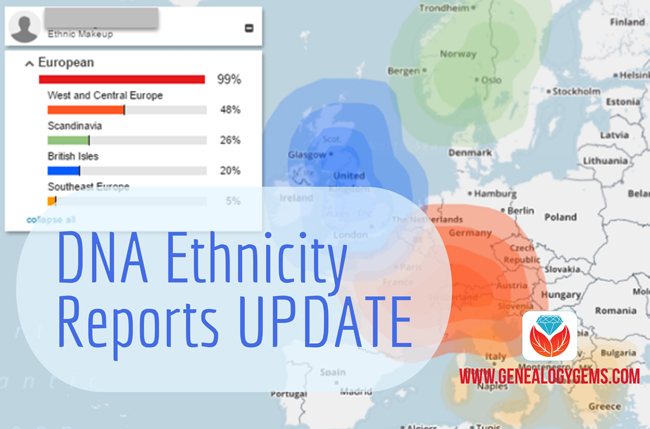
Family Tree DNA recently announced a round of updates to myOrigins, its mapping tool for ethnic and geographic ancestry. New are more detailed breakdowns of their population clusters and in-depth descriptions of them. (Visit Family Tree DNA’s website here.)
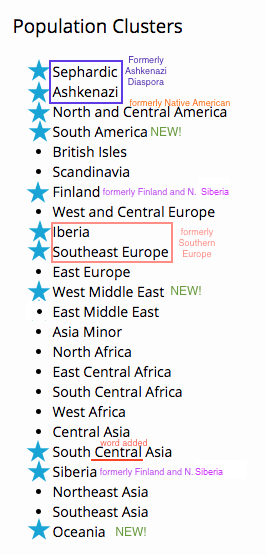
It is so exciting to see new or updated reports from our genetic genealogy testing companies! It is a good reminder of two things: First, that the results we currently have, especially in the arena of our ethnicity results, will continually be improving. Second, that once you test with any company, these improvements are added to your account and your results are updated automatically.
Family Tree DNA is the only company offering a complete look at your mitochondrial DNA (mtDNA), the one that traces your direct maternal line. They recently updated the deep ancestral assignments for these mtDNA tests. The updates were based on scientific advances in the world of mtDNA and can sometimes give you a more specific idea of where your ancestral line came from.
In addition to the mtDNA updates, FTDNA has also updated their MyOrigins results as part of your autosomal DNA test. Previously your MyOrigins results broke up the world into 18 different pieces and you were told your affiliation with each. Now with 6 new populations added, there are a total of 24. The changes include splitting three categories into smaller parts, like they are now reporting Finland separate from Siberia, as well as adding three new categories in South America, West Middle East, and Oceania.
Your MyOrigins results will now also include trace amounts, which are those percentages that are very low and therefore do not carry a high confidence. But many genetic genealogists wanted to see any area that may have been detected, and so FTDNA responded.
How to Review Your Family Tree DNA Ethnicity Report
1. Log in to your Family Tree DNA account. From your dashboard, select myOrigins.
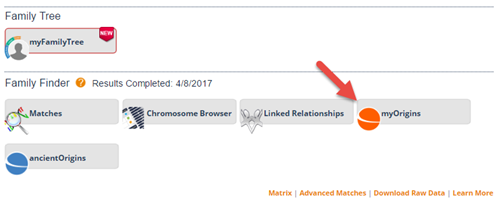
2. On the myOrigins page, click View all to see your full ethnic percentages, as defined by Family Tree DNA. You can also click View myOrigins map to see your results mapped out. (The map looks like the one at the beginning of this post.)
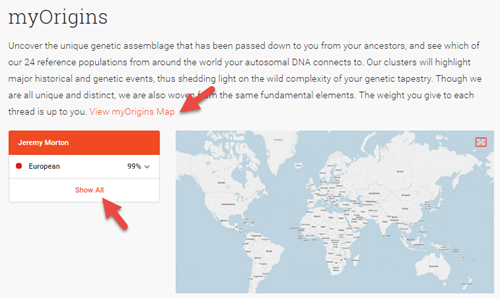
3. When you click to view all your ethnicity results, you’ll see a more detailed breakdown of your population groups. Click View all population descriptions to read more about each one.
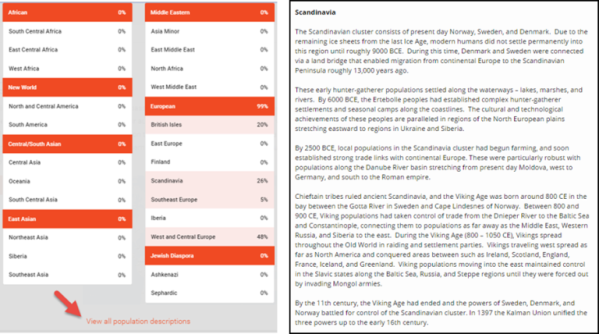
The Impact of Updated Family Tree DNA Ethnicity Reports
On the whole, are these updated results going to significantly impact your family history research if you have tested at Family Tree DNA? Likely not. The greater impact is just in the idea that these things can be improved, updated, and changed, which means our experience will continue to improve, and more people are likely to test. More people in the database means more possible cousins. More possible cousins means more genealogy breakthroughs, and a more complete picture of our heritage, and that is what we are really all after.
Learn More About DNA Testing for Genealogy
Click here to see individual guides for topics I talked about above, such as testing at Family Tree DNA, testing your autosomal or mitochondrial DNA and getting started (in which I explain ethnicity results). Or click here for the ultimate Genetic Genealogy Jumbo Pack: ALL 10 of my guides PLUS my video class, “Getting Started with Genetic Genealogy.”

by Lisa Cooke | Jun 25, 2015 | 01 What's New, Ancestry, DNA, images, Listeners & Readers
 Opening your AncestryDNA account to find a New Ancestor Discovery can be a bit like the experience my nine-year old had at the beach today. He noticed something unusual in the sand on his way down to the beach and excitedly used his hands to unearth the treasure. However, it turned out to be a Captain Hook figurine long lost by another (likely much younger) beach-goer. His initial excitement quickly dissipated. He was disappointed as he had clearly found something he did not need or want.
Opening your AncestryDNA account to find a New Ancestor Discovery can be a bit like the experience my nine-year old had at the beach today. He noticed something unusual in the sand on his way down to the beach and excitedly used his hands to unearth the treasure. However, it turned out to be a Captain Hook figurine long lost by another (likely much younger) beach-goer. His initial excitement quickly dissipated. He was disappointed as he had clearly found something he did not need or want.
I have heard from many of you that are confused and disappointed with Ancestry’s attempts to merge your genetics and your genealogy. Keep in mind that AncestryDNA matches are only using your genetics. Your DNA Circles and your New Ancestor Discoveries incorporate your linked tree into your genetic test results.
 Lisa recently forwarded me a comment from Kate that perfectly illustrates the confusion I’m talking about. “We had DNA done thru Ancestry,” she writes. “The results [have] made me seriously question what they are showing me. I believe they are using my tree to show me results that are more vague than they are revealing. The latest example they show is a person not related by blood. This family is related by name only (my uncle’s spouse).
Lisa recently forwarded me a comment from Kate that perfectly illustrates the confusion I’m talking about. “We had DNA done thru Ancestry,” she writes. “The results [have] made me seriously question what they are showing me. I believe they are using my tree to show me results that are more vague than they are revealing. The latest example they show is a person not related by blood. This family is related by name only (my uncle’s spouse).
“My results from Ancestry show that they use my tree to make matches. Just checked the web page for DNA results. They show numerous matches….Three or 4 contacted me because they were convinced they were related by blood when they may have had a remote tree connection. They contacted me because the DNA results showed they were a 3rd or 4th
cousin, when in fact they would only be a 3rd or 4th cousin in my tree.”
I can see why she’s confused. First, let’s review what an AncestryDNA New Ancestor Discovery (NAD) actually IS. NAD’s are based on the DNA Circle idea created by Ancestry. Remember that a DNA circle is when Ancestry can identify a shared genetic AND genealogical connection between three or more people. Using various standards and measures, they name an ancestor as your connection. This is the ancestor I affectionately call our Party Host. This is the ancestor who passed his or her DNA down to all of their descendants, like tickets inviting them to this party in the future. So, everyone who holds a ticket, AND who has honored that party host ancestor by placing their name in their pedigree chart, is listed as a guest in the form of a DNA circle connection. (Click here to read a blog post about this concept.)
The New Ancestor Discoveries just take that one step further. The NAD is an attempt to find ticket holders who have not yet taken that extra step and added that important Party Host ancestor to their family tree. The NAD is like a nudge, inviting us to double check our family tree to see if this particular ancestor might need to be added. It is important to remember that a NAD comes only after a DNA circle has already been formed, and there could have been errors in that formation. So the very first thing you need to do with a NAD is to correspond with circle members and double check that the Party Host of the circle, their common ancestor, is correct. Then we can move on to evaluating the NAD.
Ancestry admits on its help pages that there are three reasons why you might get an NAD, and only one is “right” in the way you and I might view it.
 The “right” answer comes when the DNA circle was drawn correctly, the Party Host properly identified, and your DNA connection is strong to two or more members of the circle. You are then able to verify through traditional genealogical methods that you are an actual descendant of the Party Host, holding that coveted ticket, shown in blue in this modified image from the AncestryDNA help page.
The “right” answer comes when the DNA circle was drawn correctly, the Party Host properly identified, and your DNA connection is strong to two or more members of the circle. You are then able to verify through traditional genealogical methods that you are an actual descendant of the Party Host, holding that coveted ticket, shown in blue in this modified image from the AncestryDNA help page.
There are two other alternatives.
 First, you are related to the NAD Party Host (the New Ancestor that was discovered) via marriage. In this second example from Ancestry’s help page, we see that your ancestor was married twice. The members of the DNA circle are descendants of her other marriage. Remember, that you do not share DNA with every member of the DNA circle. In this case, you share the purple DNA with a few members of the circle. But there are other members that share the blue. So the super computers at Ancestry first put all the blues together in a circle with the Party Host at the top. Then you come along with purple DNA that matches a few in the circle and their supercomputer erroneously assumes that you too must have been invited to this “blue” party, but in fact, the blue/purple members of the circle are double booked. They have been invited to both the blue and the purple party.
First, you are related to the NAD Party Host (the New Ancestor that was discovered) via marriage. In this second example from Ancestry’s help page, we see that your ancestor was married twice. The members of the DNA circle are descendants of her other marriage. Remember, that you do not share DNA with every member of the DNA circle. In this case, you share the purple DNA with a few members of the circle. But there are other members that share the blue. So the super computers at Ancestry first put all the blues together in a circle with the Party Host at the top. Then you come along with purple DNA that matches a few in the circle and their supercomputer erroneously assumes that you too must have been invited to this “blue” party, but in fact, the blue/purple members of the circle are double booked. They have been invited to both the blue and the purple party.
How can you fix this? If you can identify your purple Party Host, then you can add that person to your tree, and the trees of your DNA matches and likely then a new DNA Circle will form with the purple Party Host at its head, and the blue NAD will disappear.
 The other situation that many of you are seeing, especially those of you with ancestry from small communities, is demonstrated in Figure 3 of the Ancestry Help page, reproduced here. As you can see, this one is much more complicated. (In fact, the colors I added aren’t even quite accurate, as not all descendants of the blue NAD have the same blue, but rather different shades of blue depending on the segment they received- but this is a story for another post!)
The other situation that many of you are seeing, especially those of you with ancestry from small communities, is demonstrated in Figure 3 of the Ancestry Help page, reproduced here. As you can see, this one is much more complicated. (In fact, the colors I added aren’t even quite accurate, as not all descendants of the blue NAD have the same blue, but rather different shades of blue depending on the segment they received- but this is a story for another post!)
The short of it is, the members of the previously established DNA circle share one single ancestor with each other, but they share multiple separate and distinct ancestors with you. Looking at this chart it seems very clear, but remember, in the database we only see you and the people you match. We cannot tell from the DNA shared which piece came from which ancestor. So, it is very important to check and double check the pedigrees of those in the circle to identify additional shared lines.
The short of it is, these NAD’s are following the guilt by association rule, but in fact, you could be innocent. Just keep in mind the simple principle that you DO share a common ancestor with those members of the circle that you share DNA with. You do NOT necessarily share common ancestry with those in the circle that you do not share DNA with.
The key is to take these NAD’s for what they really are: research suggestions. Keep your expectations low, and then you will be pleasantly surprised when you are able to verify a connection.
 Ready to learn more about DNA testing for family history? Click here to watch two video interviews in which Lisa and I chat about genetic genealogy.
Ready to learn more about DNA testing for family history? Click here to watch two video interviews in which Lisa and I chat about genetic genealogy.
My DNA quick reference guides can get you started on your own DNA research, or help you unpuzzle and maximize results you don’t fully understand. Click here to see all six guides: purchase them individually or as value-priced bundles.
 Genealogy testing companies have been hard at work recalibrating your ethnicity calculations based on new and better data. Here’s the latest from Your DNA Guide Diahan Southard.
Genealogy testing companies have been hard at work recalibrating your ethnicity calculations based on new and better data. Here’s the latest from Your DNA Guide Diahan Southard. 




 You’ve taken your DNA test for genealogy and anxiously waited for your results. When they arrive, you dive into the ethnicity pie chart. Then matches start rolling in and it can become a little overwhelming to make sense of it all and the benefit it can provide to your genealogy.
You’ve taken your DNA test for genealogy and anxiously waited for your results. When they arrive, you dive into the ethnicity pie chart. Then matches start rolling in and it can become a little overwhelming to make sense of it all and the benefit it can provide to your genealogy.



 2. Take an autosomal DNA test. This test looks at both sides of a person’s biological family, mom and dad. Most people start by testing at
2. Take an autosomal DNA test. This test looks at both sides of a person’s biological family, mom and dad. Most people start by testing at 















